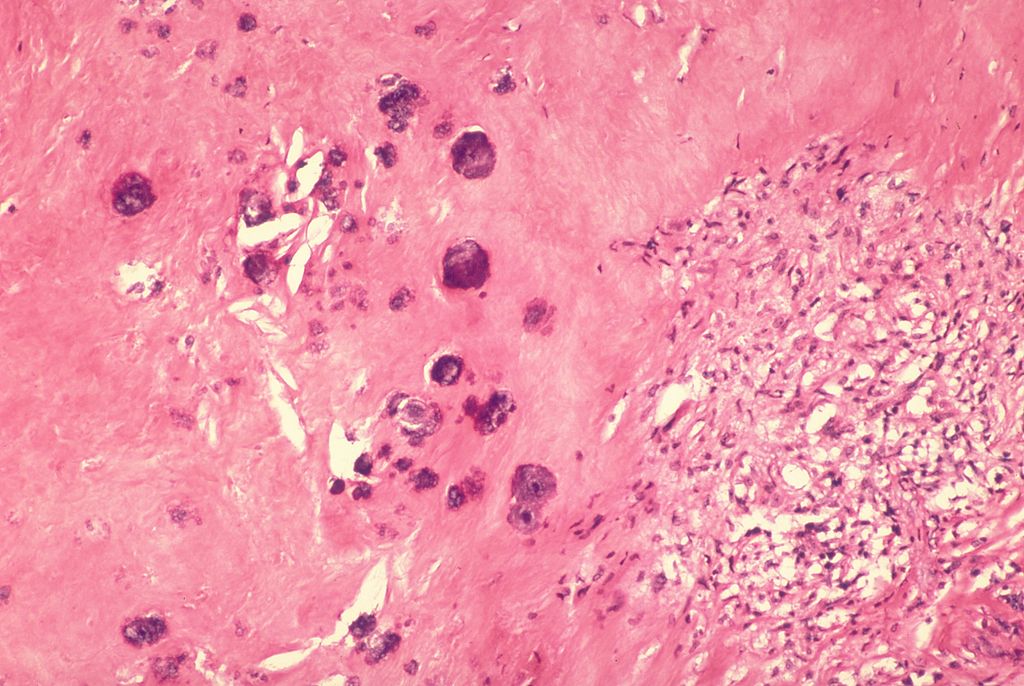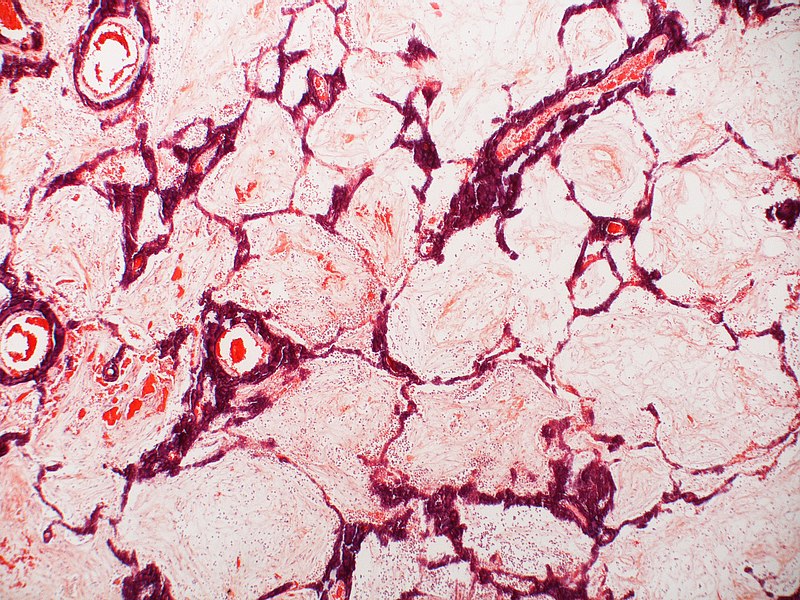Difference Between Dystrophic and Metastatic Calcification
Table of Contents
The key difference between dystrophic and metastatic calcification is that dystrophic calcification is the deposition of calcium salts in dead or degenerated tissues, while metastatic calcification is the deposition of calcium salts in normal tissues.
Calcification is the accumulation of calcium salts in body tissues. Normally it occurs in the formation of bone. But calcium also can be deposited abnormally in soft tissues. Based on whether there is a mineral balance or not, calcifications may be classified into two types: dystrophic and metastatic calcification. This is also called pathologic calcification, as it is an abnormal deposition of calcium salts in tissues other than osteoid or enamel. Dystrophic calcification occurs without a systemic mineral imbalance, while metastatic calcification occurs due to a systemic elevation of calcium levels in the blood and all tissues.
CONTENTS
1. Overview and Key Difference
2. What is Dystrophic Calcification
3. What is Metastatic Calcification
4. Similarities – Dystrophic and Metastatic Calcification
5. Dystrophic vs Metastatic Calcification in Tabular Form
6. Summary – Dystrophic vs Metastatic Calcification
What is Dystrophic Calcification?
Dystrophic calcification is the deposition of calcium salts in dead or degenerated tissues. It mainly occurs in necrotic tissues such as hyalinized scars, degenerated foci in leiomyomas, and caseous nodules. It takes place as a result of the reaction to tissue damage and as a consequence of medical device implantation. Even if the amount of calcium in the blood is not elevated, dystrophic calcification can occur. Therefore, in the case of dystrophic calcification, plasma calcium and phosphate levels are normal.

Figure 01: Dystrophic Calcification
In dystrophic calcification, deposition of calcium occurs in two phases: the initiation phase and the propagation phase. The initiation phase further divides into intracellular and extracellular. In intracellular initiation, the damaged cell has an increased inflow of calcium into the cytoplasm. The calcium that has entered has a great affinity for mitochondria and gets deposited in mitochondria. In the extracellular initiation phase, the degenerated cell has membrane-bound vesicles which contain acidic phospholipids. Calcium has a great affinity for acidic phospholipids and thus deposits in vesicles. Phosphates also accumulate in the same vesicles. Once calcium and phosphate accumulate in vesicles, they get budded out of the cell. Furthermore, calcium deposition takes place in the propagation phase. This is due to a protein called osteopontin. In dystrophic calcification, osteopontin is found in abundance. This results in the calcification of dead or degenerated tissue.
Metastatic calcification is the deposition of calcium salts in normal tissues. This is because of the elevated serum levels of calcium. The elevated serum levels of calcium occur because of deranged metabolism, increased absorption, or decreased excretion of calcium and other related minerals. This situation can be seen in hyperparathyroidism. It is named metastatic calcification because calcium from bones moves out and deposits in the distant tissues.

Figure 02: Metastatic Calcification
Metastatic calcification can occur widely throughout the body. But principally, it affects the interstitial tissues of the vasculature, kidneys, lungs, and gastric mucosa. The main causes of metastatic calcification are hyperparathyroidism, resorption of bone tissue, disorders of vitamin D, and renal failure. There are also other miscellaneous causes such as aluminium intoxication in patients with chronic renal dialysis and milk-alkali syndrome due to excessive intake of milk.
- Both terms are related to calcification.
- They are types of pathologic calcifications.
- Both are types of calcification, which consist of calcium phosphate crystals.
- They occur in body tissues.
Dystrophic calcification is the deposition of calcium salts in dead or degenerated tissues. On the other hand, metastatic calcification is the depositing of calcium salts in normal tissues. So, this is the key difference between dystrophic and metastatic calcification. Furthermore, in the case of dystrophic calcification, serum calcium level is normal, but in metastatic calcification, the serum calcium level is elevated.
The following infographic presents the difference between dystrophic and metastatic calcification in tabular form.
Summary – Dystrophic vs Metastatic Calcification
Pathologic calcification is an abnormal deposition of calcium salts in tissues other than osteoid or enamel. Pathologic calcification is classified into dystrophic and metastatic calcification. Both types of calcifications consist of calcium phosphate crystals. However, the major difference between dystrophic and metastatic calcification is that dystrophic calcification occurs in damaged tissue, while metastatic calcification occurs in normal tissue.
Reference:
1. “Soft Tissue Calcifications.” UW Radiology, 18 Apr. 2017.
2. “Metastatic Calcification.” An Overview | ScienceDirect Topics.
Image Courtesy:
1. “Sarcoidosis – Calcification (6148633106)” By Yale Rosen from USA – Sarcoidosis – CalcificationUploaded by CFCF (CC BY-SA 2.0) via Commons Wikimedia
2. “Metastatic calcification Case 141 (4962399264)” By Yale Rosen from USA – Metastatic calcification Case 141 (CC BY-SA 2.0) via Commons Wikimedia
ncG1vNJzZmivp6x7pbXFn5yrnZ6YsqOx07CcnqZemLyue8OinZ%2Bdopq7pLGMm5ytr5Wau26w2Kyrq6egnbakecCnm2allamutMDAraCcZZOWuaS1xaKamqyZpLtw